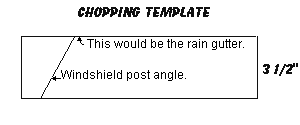|
|

The Basic Steps
The first step is to determine the amount you wish to chop. The '53-'56 F-100's look great with anything from a 2 1/2" to a 4" chop, although I have HEARD of as much as 5 1/2" being removed(I also heard that the gentleman who
did that chop also liked to peek through keyholes...TETO).
These are the cuts that you'll need to make on the door window frames and the cab's A-pillars...The back corners of the cab are nearly square cuts. There, you'll need to align the cut so that there is minimal problems in aligning the rear window opening and
the door jamb. Use lots of butcher paper and/or tape until everthing looks like it should...then check it again.

I did a 3 1/2" chop, so I built a template (a piece of sheet metal) that was exactly 3 1/2" wide, with the A-pillar angle drawn on the front of the template to determine the correct amount
to remove from that area. You can get the angle by laying a combination square on the raingutter and adjust the rule to the windshield post. Then transfer that angle to the template you are making.

KEEP your cuts square, then file down to the finish line prior to tack welding. Measure everything several times to make sure that you have everything aligned. TAKE YOUR TIME!!!
I tack welded the doors first, then started setting up the four pieces of the roof, using the door window frames as references. I used flat stock to clamp the roof pieces together with (ALIGNMENT) and checked everything again before I started tack welding the cab corners, A-pillars and cutting out the filler pieces I needed to tie
the roof together. When welding on the roof, use lots of tack welds and skip around to avoid warping the metal.
(NOTE: As a side benefit, chopping the top also gave me the opportunity to patch a BADLY done frenched antenna....)

Here's a full-on back view of the completed top chop....Surprisingly, if you sit inside the cab and look out that slit that was once a back window, there's still a lot of room to see....COOL!
As you can see, there's still a lot of old body filler all over. Dipping wasn't an available option and sandblasting is too rough on the sheetmetal...that means chemical stripper and elbow-grease..
(Keep that stuff off your skin and make SURE you wash before using the bathroom unless you're into inventing a DANCE! [P.S. A loud SCREAM would be appropriate here.])
These are cool looking side and frontal views which will both be replaced by better shots in the near future.
I hope you've enjoyed these pictures, there are more details on the way so check back...Jack

